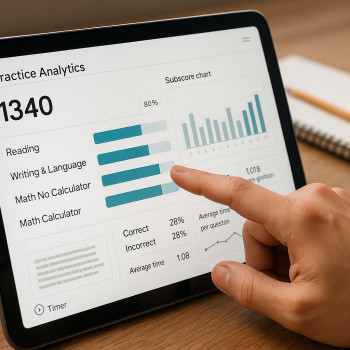Why Sleep, Diet, and Exercise Matter More Than You Think
When you’re deep into SAT prep—practice tests, problem sets, and timed sections—it’s tempting to treat sleep, food, and workouts as optional background tasks. But your brain isn’t a machine that runs better the longer it’s pushed; it’s more like a phone that needs occasional charging, cooling, and the right apps updated. The interplay between sleep, nutrition, and physical activity directly affects attention, memory consolidation, stress resilience, and stamina during long test sessions. If you’re prepping for the Digital SAT, which requires mental agility and stamina for adaptive sections, these lifestyle levers are your secret study tools.
The science in a sentence
Good sleep consolidates what you learn, balanced nutrition fuels cognitive performance, and regular exercise increases focus and reduces test anxiety. Together they create an upward spiral: better sleep improves appetite regulation and energy for workouts; exercise improves sleep quality; balanced meals sustain both study sessions and recovery. In short, you don’t just study smarter—you live smarter.
Build a Prep Routine That Respects Your Biology
Routines reduce decision fatigue. Designing daily rhythms that integrate study blocks with sleep, meals, and movement keeps your energy steady and helps you perform consistently on practice tests and test day.
Sample daily schedule for a student
Below is an example you can customize based on school hours, personal chronotype (are you a morning person or night owl?), and test date proximity. This routine assumes you’re juggling school plus SAT prep—adjust proportions if you’re on a gap period or intensive study block.
| Time | Activity | Why it helps |
|---|---|---|
| 6:30–7:00 AM | Wake up + light exposure + 10-min mobility | Resets circadian rhythm, eases morning stiffness |
| 7:00–7:30 AM | Balanced breakfast (protein + complex carbs) | Stable energy for morning classes or sessions |
| 8:00–3:00 PM | School / classes; short walk at lunch | Movement breaks keep focus and mood steady |
| 4:00–6:00 PM | Focused SAT study block (with 5–10 min breaks each hour) | High-quality practice when fresh after a break |
| 6:15–7:00 PM | Dinner (balanced) + light social time | Refuels and lowers stress |
| 7:30–8:30 PM | Light review / flashcards / strategy work | Practice without intense cognitive load; ideal for consolidation |
| 9:00–10:00 PM | Wind-down routine (no screens 30–45 min before bed) | Improves sleep onset and quality |
| 10:00–10:30 PM | Sleep | Consistent sleep window supports memory retention |
This schedule is just a template—if you’re a night person, shift everything later. The key is consistency: aim for similar wake and sleep times even on weekends, especially in the month before the test.
Sleep: Your Non-Negotiable Study Partner
Think of sleep as the study session between study sessions. During deep sleep and REM, your brain consolidates facts, vocabulary, formulas, and problem-solving strategies into long-term memory. Skipping sleep for an extra practice test might feel productive in the short run, but impaired recall, slower reaction times, and higher stress can cancel out any gains.
Practical sleep strategies for SAT prep
- Set a fixed sleep window: Aim for 7–9 hours. Track your sleep consistency for a couple of weeks and prioritize the schedule that gives you steady daytime focus.
- Wind-down routine: Turn off bright screens 45 minutes before bed. Replace scrolling with low-effort, calming habits—light reading (non-study), journaling, or breathing exercises.
- Power naps: 20–30 minutes can boost alertness. Avoid naps after 4 pm to prevent night sleep disruption.
- Practice-test sleep simulation: If your test starts early, simulate test-day wake times in the week leading up to the exam so your body is primed for morning performance.
- Manage caffeine wisely: Save coffee or energy drinks for earlier in the day. Avoid caffeine within 6 hours of bedtime.
Example: Sleep-friendly prep week
During a full practice-test weekend, prioritize a consistent bedtime for at least three nights before the practice test. That way, the score you earn reflects your true potential and not sleep debt.
Food That Fuels Focus: Smart Nutrition for Test Performance
Meals that stabilize blood sugar and provide steady cognitive fuel make long study sessions less brutal and help sustain focus during the Digital SAT’s adaptive blocks. Instead of crash-and-burn meals, think of combining slow-release carbohydrates, lean proteins, healthy fats, and micronutrient-rich fruits and vegetables.
Simple plate rules
- Include protein at every major meal (eggs, yogurt, tofu, chicken, beans).
- Choose whole grains: oats, brown rice, quinoa, or whole-grain bread keep blood sugar stable.
- Add healthy fats for brain function: avocado, nuts, seeds, olive oil.
- Color your plate with vegetables and fruit for vitamins and antioxidants.
- Hydrate consistently; even mild dehydration hurts concentration.
Grab-and-go SAT-friendly meals
- Breakfast: Greek yogurt + berries + a spoon of nut butter + granola.
- Snack: Apple slices with almond butter or a small handful of mixed nuts.
- Lunch: Grain bowl with quinoa, roasted veggies, chickpeas, and a lemon-tahini dressing.
- Dinner: Salmon or lentils + sweet potato + steamed greens.
- Pre-test morning: Oatmeal with banana and a small amount of protein (Greek yogurt or an egg).
What to avoid before a practice test or test day
- Heavy, greasy meals that make you sluggish.
- Sugary drinks or pastries that spike then crash blood sugar.
- Trying entirely new foods that might upset your stomach.
Move to Improve: Exercise That Boosts Learning
You don’t need to train like an athlete to get cognitive benefits—regular moderate exercise increases blood flow to the brain, improves mood, and lowers anxiety. Even small bouts of movement during study sessions can refresh your focus.
Types of exercise that help SAT prep
- Cardio (20–30 minutes, 3–5 times/week): brisk walking, jogging, cycling—improves alertness and executive function.
- Strength or resistance training (2–3 times/week): helps long-term stress resilience and physical energy.
- Mobility and stretching (daily short sessions): counteracts long sitting periods and improves posture for long test sessions.
- Short movement breaks (5–10 minutes each hour): bodyweight squats, a quick walk, or jumping jacks reset attention.
Practical plan for busy students
Schedule small wins: 10 minutes of mobility after waking, 20–30 minutes of cardio after school, and a 5-minute stretch break during each study hour. The cumulative effect is powerful; energy management across the day keeps mental fatigue at bay.
Integrating the Three: Weekly Checklists and Realistic Targets
Balancing sleep, diet, and exercise isn’t about perfection—it’s about reliable throughput. Accountability tools, short-term goals, and small rituals are what make healthy habits stick during an intense prep period.
Weekly checklist you can adapt
- Sleep: 7–9 hours on at least 5 nights; consistent wake time within 60 minutes.
- Nutrition: 3 balanced meals per day + 1–2 healthy snacks; bring a test-morning meal plan into practice.
- Exercise: 3 cardio sessions + 2 strength sessions (or 150 minutes of moderate activity total) and daily 5-minute movement breaks.
- Mind training: 10 minutes of breathing or mindfulness 4 times/week to manage test-day nerves.
- Practice tests: One full-length practice test every 1–2 weeks with simulated sleep, meals, and breaks.
Small habit swaps that make a big difference
- Swap a sugary snack for a piece of fruit + cheese to maintain focus.
- Replace late-night scrolling with a 10-minute reflection on what you learned—then lights out.
- After a study hour, do 3 minutes of brisk movement before returning to the desk.
Using Practice Tests to Rehearse the Whole Experience
Practice tests are not just about content; they’re rehearsals for the physical and mental conditions of test day. Treat each full-length practice test like a dress rehearsal: same wake time, same breakfast, same movement breaks, and the same test-day logistics. This strategy helps you figure out which foods sustain you, whether that 20-minute pre-test walk helps or hinders, and how long you need to warm up mentally.
Checklist for a realistic practice-test day
- Wake at your test-day time for at least three days before the test.
- Eat the breakfast you plan to eat on test day.
- Complete the test in one sitting with the same break pattern you’ll use on test day.
- Note energy dips and what snacks or breaks helped most.
Handling Stress and Unexpected Disruptions
No matter how organized you are, life happens: a bad night’s sleep, an upset stomach, or a surprise school event. The trick is resilience: the ability to quickly restore equilibrium so one event doesn’t derail weeks of good work.
Quick recovery tactics
- If you sleep poorly: skip the temptation to nap for hours—do a 20–30 minute power nap late morning, then reset your bedtime that night.
- If you overeat or feel sluggish: gentle movement and hydration help. Avoid self-criticism—focus on the next meal and the next study block.
- If you skip exercise: do a short, intense 10–15 minute bodyweight session to reboot energy.
How Personalized Support Can Keep You Consistent
Building and sustaining balanced habits is easier when someone helps you troubleshoot and stay accountable. That’s where tailored tutoring and support can be a game-changer. For many students, working with an expert tutor or a personalized program means not just better content review but also customized daily plans that fit your sleep tendencies, nutritional preferences, and activity levels.
What to expect from personalized tutoring
- 1-on-1 guidance that fits your schedule and energy patterns.
- Tailored study plans that reserve cognitive-heavy tasks for your peak hours.
- Expert tutors who help you rehearse test-day logistics—sleep timing, meal choices, and break strategies—so you arrive prepared.
- AI-driven insights that track your practice-test performance and recommend recovery strategies, such as adjusting sleep or adding movement between study blocks.
Services like Sparkl’s personalized tutoring can provide this level of individualization—helping you balance the lifestyle pieces with study goals so your mental and physical prep are synchronized rather than competing for bandwidth.
Practical Examples: Two Realistic Student Profiles
Case A: The Busy High Schooler
Background: Full school day, extracurriculars, aiming for a strong score next fall. Challenge: Time-squeeze and tendency to study late.
- Sleep plan: Fixed wake time at 6:30 AM, bedtime gradually moved earlier by 15 minutes each night until reaching a 10:00 PM sleep time.
- Nutrition tweaks: Pack oatmeal cups and a protein bar for morning commutes; swap late-night study snacks for fruit and nuts.
- Exercise routine: 20-minute run or bike after school three times a week; daily 5-minute desk mobility.
- Results: More consistent attention in afternoon study blocks and fewer late-night cram sessions.
Case B: The Evening Learner
Background: More alert in the evening, works a part-time job, planning to take the Digital SAT in three months. Challenge: Aligning practice tests with an early test start time.
- Sleep plan: Gradually shift wake time earlier by 30 minutes per week, practice waking at test-day time for three days before practice tests.
- Nutrition tweaks: Hearty lunch with protein and carbs to fuel evening study sessions; light, easily digestible dinner two hours before sleep.
- Exercise routine: Evening strength sessions twice a week, low-intensity cardio in the morning on test-simulation days.
- Results: Improved morning alertness on practice tests and better simulation of test-day energy rhythms.
What to Do in the Week Before the Digital SAT
This phase is about consolidation and stability, not gaining new skills. Your habits now determine how well you translate months of work into peak performance.
Seven-day checklist
- Sleep: Keep bed and wake times consistent. Avoid late-night marathon study sessions.
- Nutrition: Stick with familiar, balanced meals; avoid new spicy or heavy foods the night before.
- Exercise: Light to moderate activity; avoid exhausting workouts 48 hours before the test.
- Practice: One full-length practice test early in the week with all routines replicated; then focus on light review.
- Mental prep: Visualize the test day—arrival, seating, and handling a tough question without panic.
On Test Day: Small Choices, Big Impact
The morning of the Digital SAT is the product of your preparation. Simple, reliable rituals trump risky experiments.
Test-day quick guide
- Wake up at your practiced time. Avoid drastic schedule changes.
- Eat your tested breakfast. Aim for slow-release carbs and protein.
- Hydrate, but don’t overdo liquids right before the test.
- Do a brief movement routine to circulate blood and sharpen alertness.
- Arrive early, calm, and confident—trust the rehearsals.
Final Thought: Small Habits, Steady Gains
SAT prep is a marathon of attention and good choices. Sleep, diet, and exercise aren’t an optional appendix to your study plan—they are the scaffolding that lets your learning stand tall on test day. You don’t need perfect balance every day; you need consistent, sensible choices that add up. Use practice tests to rehearse the whole experience—sleep, meals, exercise, and study blocks—and refine what works for you.
If you want a study plan that integrates these lifestyle pieces with your academic strengths and weaknesses, consider personalized tutoring that builds a schedule around your biology and life—1-on-1 guidance, tailored study plans, and expert input can make the difference between a rough attempt and your best possible performance.
Next steps to put this into action
- Pick one sleep goal, one nutrition swap, and one movement habit to implement this week.
- Schedule a full-length practice test with your new routine and treat it like the real thing.
- Track how your energy and focus change—adjust small elements rather than overhauling everything at once.
Good habits compound. The choices you make now—consistent sleep, steady fuel, and simple movement—become the foundation for clear thinking and calm performance on the Digital SAT. Breathe, plan small, and practice the whole experience. You’ve got this.












No Comments
Leave a comment Cancel